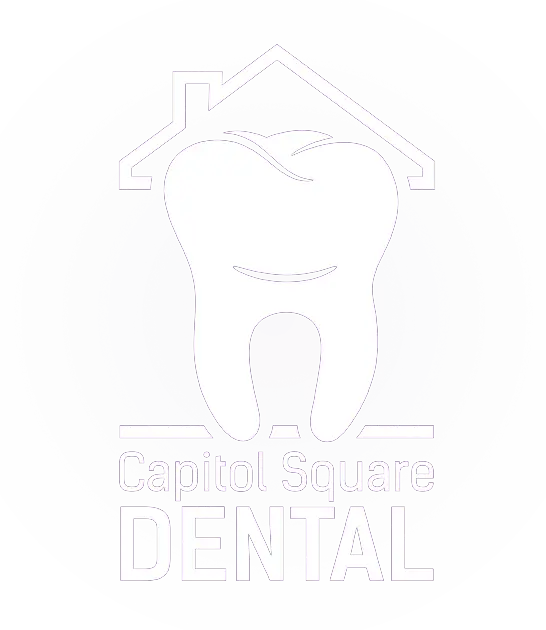Invisalign vs. Braces: Which Option is Right for You?
Posted on 10/1/2023 by Office at Capitol Square Dental |
 One of the most common dental concerns is tooth misalignment, often referred to as malocclusion. There are several types including underbite, overbite, open bite, crossbite, and more. In some cases, the issue is so minor that no intervention is needed. However, in some cases, it is so extreme that surgical intervention is needed. One of the most common dental concerns is tooth misalignment, often referred to as malocclusion. There are several types including underbite, overbite, open bite, crossbite, and more. In some cases, the issue is so minor that no intervention is needed. However, in some cases, it is so extreme that surgical intervention is needed.
Somewhere in the middle of these two extremes lies mild to moderate issues. These are often treated with either traditional metal braces or Invisalign clear aligners. This article explains what you need to know about these two options at Capitol Square Dental.
WHAT IS INVISALIGN?
Invisalign is a brand of clear aligners, which are a type of orthodontic treatment used to straighten and align teeth. Invisalign offers a more discreet and flexible alternative to traditional metal braces. The treatment involves wearing a series of custom-made, clear plastic aligners that gradually move the teeth into their desired positions.
Key features of Invisalign include:
| • |
Clear and Removable
|
| • |
Custom-Made
|
| • |
Gradual Tooth Movement
|
| • |
Comfortable and Smooth
|
| • |
Reduced Treatment Visibility
|
| • |
No Dietary Restrictions
|
| • |
Regular Monitoring |
Patients typically have regular check-ups with their orthodontist to monitor progress and receive new sets of aligners. The number of aligners and the duration of treatment vary based on the complexity of the case.
Invisalign is effective for treating a range of orthodontic issues, including crowded teeth, gaps, overbites, underbites, and crossbites. However, it may not be suitable for all cases, and the decision between Invisalign and traditional braces depends on individual needs and the recommendations of the orthodontic provider.
WHAT ARE TRADITIONAL BRACES?
Traditional braces are a type of orthodontic treatment that uses metal brackets, wires, and bands to straighten and align teeth. They have been a popular and effective method for correcting various orthodontic issues for many decades. Here are the key components of traditional braces:
| • |
Metal Brackets
|
| • |
Archwire
|
| • |
Bands
|
| • |
Elastics or Rubber Bands
|
| • |
Adjustments |
Traditional braces are effective for treating a wide range of orthodontic issues, including crowded teeth, gaps, misaligned bites, and more. While they have been a reliable method for many years, advancements in orthodontics have introduced alternative options, such as Invisalign, which offers a more discreet and removable approach to orthodontic treatment.
It’s important to note that traditional braces are suitable for patients of all ages, and they remain a popular choice for individuals who require comprehensive orthodontic correction. The duration of treatment with traditional braces varies depending on the complexity of the case but often ranges from 18 to 24 months. Regular oral hygiene practices and adjustments by the orthodontist are essential for the success of traditional braces treatment.
INVISALIGN VS. TRADITIONAL BRACES
| Feature | Invisalign | Traditional Braces | | Appearance | Clear, nearly invisible aligners | Metal brackets and wires | | Comfort | Generally more comfortable as there are no wires or brackets | Initial discomfort and potential irritation from wires | | Removability | Removable for eating, brushing, and special occasions | Fixed in place until treatment completion | | Cleaning | Easy to clean; aligners are removable for thorough oral hygiene | Requires more effort for cleaning around brackets | | Diet Restrictions | None; aligners are removed when eating | Some restrictions to avoid damage to braces | | Treatment Visibility | Virtually invisible during treatment | Visible, especially with metal brackets | | Treatment Duration | Average of 12-18 months, varies by case | Average of 18-24 months, varies by case | | Adjustment Appointments | Typically less frequent, as new aligners are provided at each stage | Regular adjustments are needed every 4-6 weeks | | Emergencies | Fewer emergencies; broken aligners can be replaced easily | More potential for emergencies, such as broken brackets | | Speech Impact | Minimal impact on speech/td> | This may cause slight speech adjustments initially | | Effectiveness | Effective for a wide range of orthodontic issues | Effective for all types of orthodontic issues | | Cost | Varies; can be comparable or slightly more expensive than braces | Varies; metal braces are generally more affordable | | Insurance Coverage | Coverage varies by insurance plan | Generally covered by dental insurance |
COST OF INVISALIGN VS. TRADITIONAL BRACES
The cost of Invisalign vs. traditional braces can vary widely and is influenced by several factors, including the complexity of the orthodontic issues, the duration of treatment, geographic location, and the specific provider. Here’s a general overview:
INVISALIGN
| • |
The cost of Invisalign treatment typically ranges from $3,000 to $8,000 or more.
|
| • |
In some cases, Invisalign may be comparable in cost to traditional braces, while in other cases, it may be slightly more expensive. |
The cost can be influenced by the number of aligners needed, the complexity of the case, and the length of the treatment plan.
TRADITIONAL BRACES
| • |
The cost of traditional braces generally ranges from $2,500 to $7,000 or more.
|
| • |
Metal braces are often perceived as a more cost-effective option compared to Invisalign.
|
| • |
The total cost is influenced by factors such as the severity of the orthodontic issues, the length of treatment, and the need for additional appliances. |
It’s important to note that these cost ranges are general estimates, and actual costs can vary significantly based on individual factors and the geographic location of the dental practice. Additionally, the inclusion of insurance coverage and any available discounts or payment plans can affect the overall out-of-pocket cost for the patient.
FACTORS INFLUENCING ORTHODONTIC TREATMENT COST
Several factors can influence the cost of orthodontic treatment, including:
INSURANCE COVERAGE
Check with your dental insurance provider to understand the extent of coverage for orthodontic treatments. Some plans may cover a portion of the cost.
TREATMENT COMPLEXITY
More complex cases may require longer treatment periods and additional orthodontic appliances, impacting the overall cost.
GEOGRAPHIC LOCATION
Dental care costs can vary based on the region and the cost of living in that area.
PROVIDER’S EXPERIENCE
Experienced orthodontists may charge higher fees for their services.
ADDITIONAL TREATMENTS
Some cases may require additional treatments or procedures, such as attachments or refinements, which can increase the overall cost.
It’s recommended to schedule consultations with orthodontic providers to get personalized cost estimates based on your specific orthodontic needs. Additionally, inquire about available payment plans, financing options, and any discounts that may help make the treatment more affordable for you.
SHOULD I GET INVISALIGN OR TRADITIONAL BRACES?
The decision to choose between Invisalign and traditional braces depends on various factors, including your orthodontic needs, lifestyle preferences, and personal considerations.
SCHEDULE YOUR ORTHODONTICS CONSULTATION AT Capitol Square Dental TODAY
If you have mild to moderate malocclusion, schedule your orthodontics consultation at Capitol Square Dental today. We offer both traditional braces and Invisalign clear aligners. We start with a consultation to determine the type and severity of your malocclusion, as well as your lifestyle preferences and personal considerations.
We will work with you to help you create the picture-perfect smile you’ve always dreamed of.
INVISALIGN VS. BRACES FAQS
If you have questions or concerns about orthodontics at Capitol Square Dental, we are here to help. We believe that patient education should be a priority. Below are a few of the most common questions that we get.
HOW MUCH DOES INVISALIGN COST?
Invisalign treatment ranges in cost from around $1,200 to $8,000 based on a variety of factors including the type and severity of your malocclusion.
HOW TO CLEAN INVISALIGN?
Cleaning Invisalign clear aligners is easy.
Remove aligners
| • |
Rinse with cool running water
|
| • |
Brush with a soft-bristled toothbrush and clear, unscented antibacterial soap
|
| • |
Rinse with cool running water until all soap residue is removed
|
| • |
Brush teeth before placing aligners back in the mouth
|
| • |
Avoid using harsh or colored cleansers, as they could damage the aligners. |
CAN YOU SMOKE WITH INVISALIGN?
Smoking is detrimental to your oral and overall health. If you are a smoker, it’s a good idea to quit if possible. However, if you must smoke, you should never smoke while wearing the aligners. You can smoke during the limited time that you can have the aligners out of your mouth.
CAN YOU GET INVISALIGN WITH A CROWN?
Invisalign treatment is possible for individuals with dental crowns, but the success and feasibility depend on the specific case. Invisalign aligners work by gradually moving teeth into their desired positions, and they are custom-made for each patient’s unique dental anatomy.
HOW TO REMOVE INVISALIGN?
Removing Invisalign clear aligners is a straightforward process, but it’s important to do it correctly to avoid damaging the aligners or your teeth. Here are step-by-step instructions on how to remove Invisalign clear aligners:
| • |
Wash Your Hands
|
| • |
Start from the Back
|
| • |
Gently Lift
|
| • |
Move to the Front
|
| • |
Use Both Hands
|
| • |
Remove the Bottom and Top Aligners Separately
|
| • |
Be Patient
|
| • |
Store in a Case
|
| • |
Clean Your Aligners
|
| • |
Brush and Floss Your Teeth |
Remember to follow your orthodontist’s specific instructions for wearing and caring for your Invisalign aligners. If you have difficulty removing the aligners or encounter any issues, consult with your orthodontic provider for guidance. |
|
